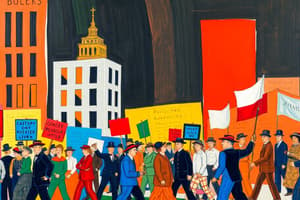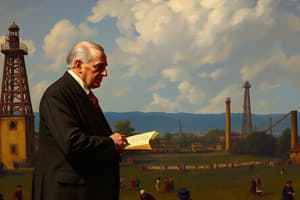Podcast
Questions and Answers
Who is considered one of the first industrial moguls to make his fortune?
Who is considered one of the first industrial moguls to make his fortune?
- Andrew Carnegie (correct)
- Eugene V. Debs
- John D. Rockefeller
- Samuel Gompers
What did Andrew Carnegie do with the money he earned?
What did Andrew Carnegie do with the money he earned?
- Supported charities (correct)
- Invested in real estate
- Built factories
- Gave it all away
What process did Carnegie witness that influenced his entry into the steel business?
What process did Carnegie witness that influenced his entry into the steel business?
Bessemer process
Vertical integration involves controlling all aspects of production from raw materials to finished product.
Vertical integration involves controlling all aspects of production from raw materials to finished product.
Eugene V. Debs was known for his support of the American Federation of Labor.
Eugene V. Debs was known for his support of the American Federation of Labor.
Andrew Carnegie's company manufactured more steel than all the factories in _____ by 1899.
Andrew Carnegie's company manufactured more steel than all the factories in _____ by 1899.
Match the following individuals with their respective contributions or roles:
Match the following individuals with their respective contributions or roles:
Republican presidential candidate _____________ won the election of 1896 over the Democratic and Populist candidate, _________.
Republican presidential candidate _____________ won the election of 1896 over the Democratic and Populist candidate, _________.
Who won the election of 1896?
Who won the election of 1896?
Flashcards are hidden until you start studying
Study Notes
Growth of Big Business
- Industrial Expansion: The expansion of industry in the late 19th century led to the growth of big business.
- Labor Unions: Laboring class formed labor unions to improve their working conditions and earn more money.
- Strategies Used Today: Many of the business and labor strategies used today have origins in the late 19th century.
Andrew Carnegie
- Immigration and Early Life: Came to the United States in 1848 at age 12 from poverty in Scotland.
- Pennsylvania Railroad: Worked his way up to become a private secretary at the Pennsylvania Railroad, using his intelligence and work ethic to gain success.
- First Dividend: Was rewarded by his boss Thomas A. Scott for successfully resolving a scheduling conflict. This reward involved purchasing stock in the Pennsylvania Railroad.
- Investing and the "Golden Egg": Carnegie's mother mortgaged the family house to allow him to buy shares in the railroad, and his first dividend was a check for $10. This event led him on the path of becoming an industrial mogul.
- American Success Story: Carnegie's "rags-to-riches" story is an example of the classic American Dream, as he ascended from poverty to wealth and created charitable organizations to help others.
- Entering the Steel Industry: After witnessing the Bessemer process in Great Britain, Carnegie entered the steel business in 1873.
- Carnegie Steel Company: Carnegie's steel company was successful and, by 1899, produced more steel than all of Great Britain.
- Leadership and Philanthropy: Carnegie was known for his management practices and for donating to charities to support education and the arts.
Business Strategies
- Vertical Integration: Carnegie implemented vertical integration, controlling all aspects of production from raw materials to distribution, by acquiring industries that provided the resources needed to produce steel.
- Horizontal Integration: This involves acquiring competitors within the same industry. Not explicitly mentioned in the text, but it implies that Carnegie may have also practiced this strategy.
- Bessemer Process: The Bessemer process was an innovative steel-making process that allowed for faster and more efficient production of steel, and it was widely adopted in the late 19th century.
- New Business Strategies: Carnegie was a pioneer in the use of vertical integration and other management techniques that became standard practices for businesses seeking to expand in the late 19th century.
Labor Unions and Leaders
- American Federation of Labor (AFL): A union formed for skilled workers to gain better wages and working conditions. Samuel Gompers was the first president of the AFL.
- Industrial Workers of the World (IWW): Also known as the "Wobblies," was a labor organization that aimed to unite all workers into one big union, regardless of skill or background. Eugene V. Debs, a key figure in the socialist movement, was a prominent leader of the IWW.
- Mary Harris Jones: Also known as "Mother Jones," was a labor activist who fought for workers' rights, organizing strikes and advocating for better working conditions.
1896 Presidential Election
- The 1896 presidential election saw a Republican victory.
- William McKinley, the Republican candidate, won the election.
- His opponent was William Jennings Bryan, who ran on both the Democratic and Populist tickets.
- The election was highly contested and focused on key economic issues, such as the gold standard.
- McKinley's win marked the beginning of a period of Republican dominance in American politics.
Studying That Suits You
Use AI to generate personalized quizzes and flashcards to suit your learning preferences.




